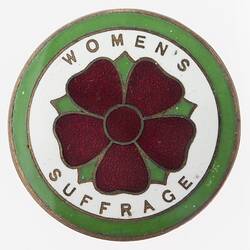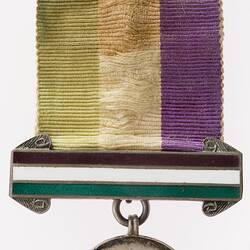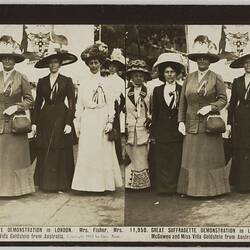The front placard of the muffineer reads 'we can make things hot for you'. This refers to the militant tactics of the Women's Social and Political Union (WSPU) which advertised female suffrage via public agitation and spectacle.
Militant activism began in 1905 when Christabel Pankhurst and fellow suffragette Annie Kenney attended a Manchester public meeting. Despite persistently asking those politicians present if a Liberal Government would give women the vote, they were ignored before they were literally dragged away.[1] Their actions epitomise what came to be WSPU policy 'long before any question of stone throwing ever arose'.[2] Militancy involved both asking questions of politicians at public meetings and demonstrating, particularly outside the Parliament.[3] Suffragette's claimed that it was the stewards at public meetings who began any uproar, not the women, who often were forcefully removed from the building.[4] This tactic was deemed to have 'succeeded beyond expectation' as the 'enemy played into [their] hands'; the discontent expressed towards the women drew more attention to the cause.[5] 'We can make things hot for you' reflects the knowledge of WSPU supporters that militancy provided an effective means of bringing women's suffrage to public attention, despite the animosity suffragettes met at this challenge to the status quo.
The 'we' of 'we can make things hot for you' refers to the large numbers of women adopting WSPU militancy. Military references abounded in the WSPU publication Votes for Women; suffragettes were 'fighting the battle'.[6] Women were called on to 'come forward and say I will be a battle comrade in this great fight.I will be a woman'.[7] The names of subscribers and contributors recruited to the cause were published as a means of creating solidarity.[8] The muffineer presents the movement as a disciplined collective which, in making things 'hot' envisions a threatening female collective, destabilising the hegemony of the 'passive female'.[9]
Suffragettes used militancy to reconstruct the category of 'female' and challenge the public-private divide of society. Masculine, war-like discourse encouraged women to protest within the public sphere. This threat to the traditional 'male' space destabilised the hegemony of male authority.[10] Victorian Britain traditionally conceptualised femininity as antithetical to those qualities warranting male participation in the public sphere. Men had capacity for reason, independence and aggression, while women's so called inherent qualities of submissiveness, dependence and passivity relegated them to the private sphere.[11] Discourse concerning a 'women's sphere' and 'natural dichotomies' were employed by anti-female suffragists to justify opposition to the women's movement.[12] During 1907-8 militancy aimed to be aggravating but specifically never violent towards another person, as traditionally masculinised violence was accepted to be.[13] This created a neo-feminine form of military protest and heroism.[14] In 1908 Christabel Pankhurst said 'it may be that history will judge us as being not altogether ladylike, but.we shall have won the vote, and that is what we are fighting for'.[15] 'We can make things hot for you' uses the platform of comfort and nurturance that women provided to the domestic middle class home and introduces this militant discourse into the private home, rendering the situation 'hot' by challenging the Victorian category of women as docile beings.[16]
Parades, mass outdoor meetings and public speeches were all traditional means of public protest.[17] The muffineer's design is a miniature of the many women who publicly demonstrated in the street holding sandwich boards. The suffragettes were not the first to use theatre and display within the public space to promote their political ends.[18] Yet by using public protest as a tactic, suffragettes not only entered the public space but exploited it.[19] This tactic elucidates how the suffragist movement previously failed in drawing public and political attention to the cause.[20] Described by a contemporary as the 'latest thing in modern femininity';[21] the performance of political dissent by the female sandwich-board holder 'threw away all [the] conventional notions of what was "ladylike"'.[22] 'We can make things hot for you' is evidence that such public demonstration was successful in agitating the 'you'; those individuals and institutions against female suffrage. The muffineer furthers the reach of this public spectacle by representing it in the home, rendering the private home an inherently political space. The rear placard reads 'Votes for Women'; this was both a militant catch-cry and title of the WSPU official organ. 'We can make things hot for you' does not appear to have been a Votes for Women headline, though fiery language including 'hot' were frequently used by the newspaper.
References
[1] Pankhurst, My Own Story, 48.
[2] 'Mr. Pethick Lawrence's Defence Speech to the Jury at the Old Bailey' Votes for Women, 21 May 1912, vol. V. no. 219, 557.
[3] Emmeline Pethick Lawrence, 'The Tactics of the Suffragettes', Votes for Women, 8 March 1908, 81.
[4] Pankhurst, My Own Story, 53.
[5] Pethick Lawrence, 'The Tactics of the Suffragettes', 81.
[6] Emmeline Pethick Lawrence, 'What the Vote Means to Those who are Fighting the Battle' Votes for Women, January 1908, 49.
[7] Emmeline Pethick Lawrence, 'What the Vote Means to Those who are Fighting the Battle', 49.
[8] Morrisson, 'Marketing British Modernism' 442.
[9] Barbara Green, Spectacular Confessions: Autobiography, Performative Activism and the Sites of Suffrage 1905-1938 (New York: St. Martin's Press, 1997), 32.
[10] Angela V. John and Claire Eustance, "Shared Histories-Differing Identities: Introducing Masculinities, Male Support and Women's Suffrage" in The Men's Share? Masculinities, Male Support and Women's Suffrage in Britain 1890-1920, eds. Angela V. John and Claire Eustance, (London: Routledge, 1997), 2.
[11] Kent, Sex and Suffrage in Britain 1860-1914, 30.
[12] Kent, Sex and Suffrage in Britain 1860-1914, 31.
[13] Emmeline Pethick Lawrence, 'The Tactics of the Suffragettes', 81.
[14] Holton, "Manliness and Militancy", 114.
[15] Quoted in Green, Spectacular Confession, 36.
[16] Green, Spectacular Confession, 4.
[17] Finnegan, Selling Suffrage: Consumer Culture and Votes for Women, 45.
[18] Finnegan, Selling Suffrage: Consumer Culture and Votes for Women, 47.
[19] Morrisson, 'Marketing British Modernism' 443.
[20] Green, Spectacular Confessions, 71.
[21] Irene Cockroft, New Dawn Women: Women in the Arts and Crafts and Suffrage Movements at the Dawn of the Twentieth Century, (London: The Watts Gallery, 2005), 9.
[22] Pankhurst, My Own Story, 62.
[23] Diane Atkinson, Suffragettes in the Purple, White and Green: London 1906-14, (London: Museum of London, 1992), 23.
[24] Atkinson, Suffragettes in the Purple, White and Green, 28.
[25] Bradley, 'Women's Suffrage Souvenirs', 86.
[26] Bradley, 'Women's Suffrage Souvenirs', 79.
[27] Pankhurst, My Own Story, 119.
[28] Atkinson, Suffragettes in the Purple, White and Green: London 1906-14, 24.
[29] Votes for Women, 10 May 1912, vol. V, no. 218, 500.
[30] Votes for Women, 10 May 1912, vol. V, no. 218, 500.
[31] Pankhurst, My Own Story, 157.
[32] Pankhurst, My Own Story, 157.
More Information
-
Keywords
-
Authors
-
Article types




